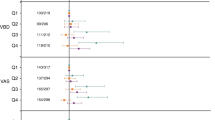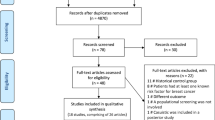Abstract
We reviewed 134 patients with breast cancer (screen detected = 85, interval = 49) who had been reported as negative at previous mammographic screening in the Florence District Programme. At prior mammograms review, 12% of the cases were classified as 'screening error' (suspicious signs missed owing to misperception or poor imaging technique), 26% as 'minimal signs present', 54% as 'radiographically occult' and 7% as 'radiographically occult at diagnosis'. These results are quite consistent with those recently reported for the Nijmegen screening programme. Screening errors may be reduced either by reducing the risk of misperception (double reading) or by improving imaging quality, but this would achieve earlier detection in a minority of cancer cases. Minimal signs of cancer were present 2 years before the diagnosis in over one-third of screen-detected cancers. Increasing screening frequency (from biennial to annual) may advance detection time of most 'screening errors' and of some cancers in the 'minimal signs present' and 'mammographically occult' categories, but this would almost double screening costs, and the benefit would probably be inferior to that obtained by doubling the population invited to biennial screening. Adopting less stringent criteria for referral to diagnostic assessment would probably lead to the detection of some cases in the 'minimal signs present' category. This seems to us a more convenient policy to adopt to advance cancer detection time, although it will also sharply increase referral rates and costs. As diagnostic assessment of minimal lesions is far from being 100% accurate, this policy would also considerably increase the frequency of unnecessary benign biopsies. All these negative effects might turn out to be unacceptable.
This is a preview of subscription content, access via your institution
Access options
Subscribe to this journal
Receive 24 print issues and online access
$259.00 per year
only $10.79 per issue
Buy this article
- Purchase on Springer Link
- Instant access to full article PDF
Prices may be subject to local taxes which are calculated during checkout
Similar content being viewed by others
Author information
Authors and Affiliations
Rights and permissions
About this article
Cite this article
Ciatto, S., Rosselli Del Turco, M. & Zappa, M. The detectability of breast cancer by screening mammography. Br J Cancer 71, 337–339 (1995). https://doi.org/10.1038/bjc.1995.67
Issue Date:
DOI: https://doi.org/10.1038/bjc.1995.67
This article is cited by
-
Analysis of interval cancers observed in an Italian mammography screening programme (2000–2006)
La radiologia medica (2009)
-
Computer-assisted diagnosis (CAD) in mammography: comparison of diagnostic accuracy of a new algorithm (Cyclopus®, Medicad) with two commercial systems
La radiologia medica (2009)
-
Real time reading in mammography breast screening
La radiologia medica (2007)
-
Taybi and Lachman’s radiology of syndromes, metabolic disorders and skeletal dysplasias
La radiologia medica (2007)
-
Breast density as a determinant of interval cancer at mammographic screening
British Journal of Cancer (2004)



